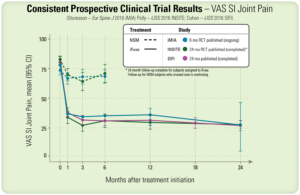Back pain is extremely common. More than 90% of people have back pain at some point. There are many possible causes for back pain, but one under appreciated source is the sacroiliac joint (SI joint). It has been suggested that dysfunction of the SI joint is responsible for back pain 15-23% of the time. As many as 40% of patients with previous lumbar fusions may have pain from the SI joint.
What is the SI joint? The spine is a column of bones. At the bottom, the spine rests on the tail bone, or sacrum. The sacrum then connects with the ilium to form the pelvis. The joint which connects the sacrum to the ilium is the SI joint.
The SI joint is a very large and stable joint. It doesn’t move very much but it can move in about any direction. It can rotate, twist, stretch, and slide.
Why does it hurt? The SI joint can develop problems for a variety of reasons. Traumatic injuries like motor vehicle accidents or falls can affect the joint. It can also be injured by over use, like in patients who do a lot of lifting or twisting.
Diagnosis. There is no good imaging study to diagnose SI joint dysfunction, but your doctor can usually get a pretty good idea if you have S I joint pain by examining you. The confirmatory test for SI joint dysfunction is an injection. If the injection relieves your pain by more than 50% it is highly likely that the source of your pain is the SI joint.
Treatments. Physical therapy or chiropractic care are the first line treatments for SI joint dysfunction. The majority of patients respond very well to therapy. For those patients who don’t, surgery can be very effective.
Here is a graph showing just how much pain relief patients who have surgery get.

If you think you might have SI joint dysfunction, or you have not gotten better with nonoperative care, you might want to talk to Dr. Ball about your options. Give us a call.

